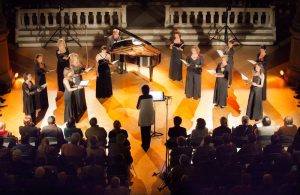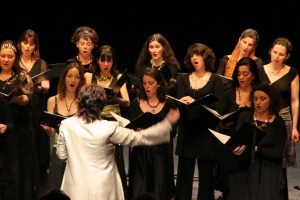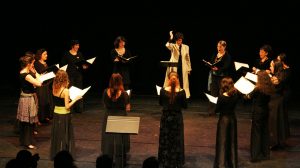Régine Theodoresco, Chorleiterin und Pädagogin, Frankreich
Wenn ein Chor- oder Orchesterleiter in der Musik von Architektur spricht, bezieht er sich meist auf die Schlüssel, die die musikalische Analyse für den Aufbau einer Interpretation liefert.
Möchte er seinen Vortrag etwas populärer gestalten, spricht er von den Stützmauern der Akkorde, die das Melodiedach tragen, oder umgekehrt von den Melodielinien, die eine komplexe, mehrstöckige Polyphonieaufbauen; er wird mit bestimmten musikalischen Wörtern (Lied, Sonate usw.) die allgemeine Form des Stücks beschreiben. Eine Form, die als solche in der Partitur nicht sichtbar ist, die aber die musikalische Aussage trägt, wenn sich diese im Klangraum entfaltet.
Der Klangraum, der vom Chor eingenommen, vom Chor befeuert und vom Chor verändert wird. Jeder von uns hat sich diese Frage mindestens einmal gestellt: Welche Anordnung soll man für den traditionellen gemischten Chor wählen? SATB von links nach rechts, oder SA vorne und TB hinten, oder SA vorne, aber BT hinten? Wenn man diese Anordnungen nacheinander ausprobiert, ist trotz der gleichen Besetzung und des gleichen Werkes das Klangergebnis sehr unterschiedlich. Man entscheidet also mit den Ohren …
Seit vielen Jahren bemühe ich mich, diesen Parameter, die Form des resultierenden Klangs als Interpretationswerkzeug, zu bearbeiten.
Wenn Sie sich ein Konzert von Calliope Voix de Femmes a cappella oder mit einem kleinen Instrumentalensemble anhören, werden Sie feststellen, dass unsere Raumnutzung in der Regel zwischen den einzelnen Stücken variiert. Und wenn Sie uns mit demselben Programm an einem anderen Ort erneut hören, werden Sie überrascht feststellen, dass sich unsere Raumaufteilung wahrscheinlich völlig verändert hat. Dasselbe gilt für einen dritten Auftrittsort.
Unsere Konzerte sind in ihrer räumlichen Gestaltung sehr vielfältig und daher für unser Publikum wenig routiniert. Aber täuschen Sie sich nicht, das ist nur eine Konsequenz und keinesfalls eine visuelle oder inszenatorische Herausforderung.
Aber wenn es nicht darum geht, die Anordnungen zu variieren, um den Raum auszufüllen oder auch nur den Nachhall zu berücksichtigen, warum dann diese Veränderungen, diese unterschiedlichen Anordnungen?
Für mich und meine Gruppe (oder meine Gruppen, denn ich gehe fast immer nach demselben Muster vor) geht es darum, eine einzigartige raumbezogene Interpretation zu schaffen, die eine Symbiose mit diesem Ort eingeht und durch die Nutzung des akustischen Raums die wichtigsten musikalischen Herausforderungen des Werks verstärkt.
Wir alle wissen, dass durch die vorherige Auseinandersetzung mit der Partitur ein mentales Bild entsteht, das uns während der gesamten Probenarbeit leitet. Wie bei vielen anderen Musikern auch, ist das Klangbild, das in meinem Kopf bis zur Besessenheit herumschwirrt, für Außenstehende schwer zu erklären. Es ist Klang, aber welcher Klang, welche Art von Klang? Was mich betrifft, weiß ich, fühle ich, dass dieses Klangbild eine bestimmte Dichte, eine Dicke, eine bestimmte räumliche Form hat. Die Arbeit an der Partitur bringt dieses Relief zum Vorschein, das sowohl der Empfindung als auch dem Wunsch nach Klang ähnelt.
Aber wie kann man diese Klangstruktur sichtbar machen und vor allem, wie kann man mit diesem Parameter arbeiten?
Ich werde ein sehr einfaches Beispiel zur Veranschaulichung heranziehen: das Ave Maria von Zoltán Kodály (für dreistimmigen Frauenchor). Ein Wechsel zwischen der tiefen Linie allein (3. Stimme), gefolgt von Punktierungen der beiden anderen Stimmen gleichzeitig, in parallelen Terzen (1. und 2. Stimme). Ich möchte die tiefe Stimme klar hören, sehr homogen, aber nicht zu dicht, mit Raum und einem guten Gleichgewicht der Obertöne, und die Antworten etwas distanzierter, mit den leisen Terzen ebenfalls etwas weiter entfernt, und vor allem als eine Einheit behandelt.
Während der Proben arbeite ich zunächst mit einer Anordnung, die ich für eine gute Grundlage halte, die der musikalischen Herausforderung dieses Werkes gerecht wird. Ich platziere die dritte Stimme in der Mitte und die Stimmen 1 & 2 durchmischt auf beiden Seiten.
Im Konzertsaal überlege ich dann zunächst, wie ich die dritten Stimmen aufstellen soll: in einer Reihe, in zwei Reihen? Wie groß soll der seitliche Abstand, die Tiefe oder sogar die Höhe zwischen den Sängerinnen sein (man wird sich wundern, wie sehr schon eine Verschiebung um 50 Zentimeter die Gesamtform des gemeinsamen Klangs verändert)? Wie sind die einzelnen Sängerinnen in der Mitte des Podests zu platzieren? Das hängt von den klanglichen Perspektivlinien des Ortes ab. Dann platziere ich auf jeder Seite des Themas die anderen Sängerinnen in zwei hinteren Diagonalen und versetzt, wobei ich die Lautstärke ausgleiche. An einem anderen Ort mit einer anderen Akustik würde ich sie vielleicht hinter dem Leitmotiv auf Stufen platzieren, in einem Halbkreis auf einer Linie um die dritten Stimmen herum oder um das Publikum herum verteilt.
Da ich die Stimmen der einzelnen Interpretinnen gut kenne und genau weiß, was ich will und was ich erwarten kann, ist der Prozess schneller, als es scheint. Manchmal jedoch „sträubt“ sich etwas in mir: Ich weiß, dass ich es besser haben kann, näher an meinem geistigen Bild, mit mehr Komfort für die Sänger. Dann gilt es, einen Schritt zurückzutreten, sich umzusehen und sich auf die Eigenschaften des Ortes zu stützen (in einer Kirche vor oder hinter dem Tragsims? hinter oder vor dem Altar? was ist mit den Stufen? wenn man sich auf einer Bühne befindet, wie weit ist der Abstand zum Kulissenvorhang, zum Bühnenhintergrund? usw.). Man findet fast immer die optimale Lösung. Dieses Vorgehen erfordert von den Sängerinnen eine große Anpassungsfähigkeit, die Fähigkeit, denselben Gesang mehrmals hintereinander zu liefern – Kraft, Artikulation usw. -, damit der Vergleich zuverlässig ist, und eine große musikalische Autonomie (damit ich in den Saal gehen und zuhören kann…).
Ich habe absichtlich ein sehr klares Werk mit hohem Einsatz genommen. Aber ich kann auch mit längeren und komplexeren Werken auf diese Weise arbeiten und dabei starke musikalische Entscheidungen treffen: Steht die fugierte Passage (die der Klarheit halber von vornherein eine stimmenweise Verräumlichung erfordern würde) im Widerspruch zur Choralpassage (die möglicherweise eine vollständige Vermischung der Stimmen erfordert)? Diese Widersprüche müssen letztlich gelöst werden! Es ist spannend und immer wieder neu.
Für das Publikum ist das Klangerlebnis sehr vielfältig oder sogar verwirrend: Es kann frontal beschallt werden, um mehr Kraft zu erhalten, oder umhüllend, um mehr Sanftheit zu erreichen, mit einer breiten oder engen, dichten oder diaphanen, diffusen oder kompakten Schallquelle.
Zusammenfassend lässt sich sagen, dass die Kohärenz als eigenständiger Parameter (gleichzusetzen mit einer Instrumentenwahl) zwischen dem zu schaffenden Klangobjekt und den Eigenschaften des Ortes die Grundlage für eine architektonische Interpretation bildet.
 Nach ihrer Ausbildung zur Pianistin wandte sich Régine Théodoresco der Orchester- und später der Chorleitung zu. Sie verfolgt eine doppelte Karriere als Interpretin und Pädagogin. Sie entwirft das Programm der Chorleitungsausbildung des Pôle d’enseignement Supérieur de Bretagne – Pays de Loire, als dieser 2011 gegründet wird, und spricht im Rahmen des Cefedem Rhône-Alpes mit angehenden Lehrkräften von Konservatorien. Mit „Calliope, Voix de Femmes“, einem professionellen Ensemble, das sie 20 Jahre lang leitete, erhielt sie zahlreiche Auszeichnungen für Schallplatten. Régine Théodoresco wirkt in zahlreichen nationalen und internationalen Jurys mit.
Nach ihrer Ausbildung zur Pianistin wandte sich Régine Théodoresco der Orchester- und später der Chorleitung zu. Sie verfolgt eine doppelte Karriere als Interpretin und Pädagogin. Sie entwirft das Programm der Chorleitungsausbildung des Pôle d’enseignement Supérieur de Bretagne – Pays de Loire, als dieser 2011 gegründet wird, und spricht im Rahmen des Cefedem Rhône-Alpes mit angehenden Lehrkräften von Konservatorien. Mit „Calliope, Voix de Femmes“, einem professionellen Ensemble, das sie 20 Jahre lang leitete, erhielt sie zahlreiche Auszeichnungen für Schallplatten. Régine Théodoresco wirkt in zahlreichen nationalen und internationalen Jurys mit.
Übersetzt aus dem Französischen von Petra Baum, Deutschland





